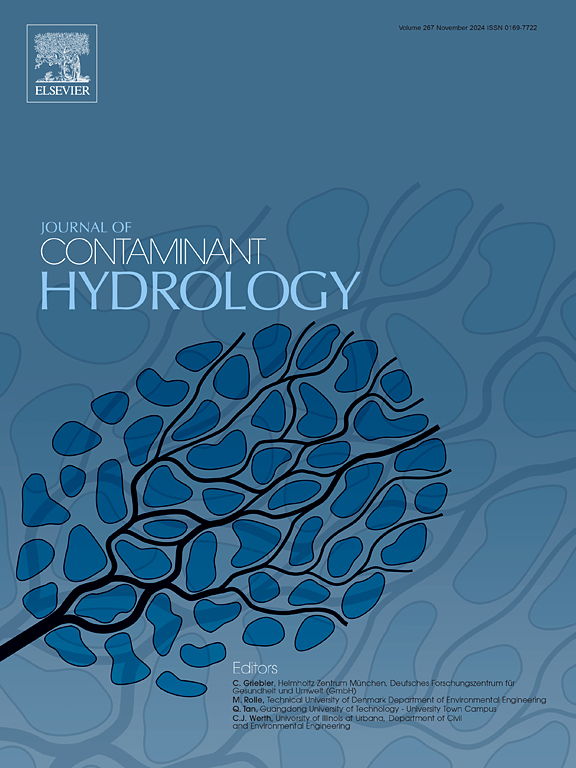印度普杜切里Ariyankuppam河微塑料激增:丰度、特征和污染负荷指数的研究
IF 4.4
3区 环境科学与生态学
Q2 ENVIRONMENTAL SCIENCES
引用次数: 0
摘要
水生环境中微塑料(MP)污染的日益严重对海洋生态系统构成了日益严重的威胁,并给人类带来了若干健康问题。近几十年来,海洋和海洋的多氯联苯污染一直是一个严重的问题,河流被认为是将多氯联苯输送到海洋的主要渠道之一。在这里,我们调查了Ariyankuppam河的MP丰度,这条河流经印度南部的Puducherry地区,并与孟加拉湾合并。从2024年1月到3月,在三个月内从沿河的十个地点收集了水和沉积物样本,与普杜切里的季风后阶段相吻合,以了解季节变化对MP丰度的影响。沉积物和水中的平均MP丰度分别为136.33±24.75和124.83±22.44颗粒/L。共检测到7837个MP颗粒,其中约52.2%和47.8%来自沉积物和水样。纤维是主要的聚合物形式,在沉积物中丰度为79.4%,在水样中丰度为87.9%。微颗粒(0 ~ 3000 μm)以小颗粒为主,主要分布在0 ~ 500 μm和500 ~ 1000 μm范围内。高密度聚乙烯(HDPE)和低密度聚乙烯(LDPE)是沿江10个测点沉积物和水样中主要的聚合物类型。我们的结果发现,在沉积物和水样中,MP丰度在几个月内没有太大的显着差异。污染负荷指数(PLI)评估显示危害级别为I (<10),这是一个最小的风险级别。这些数据将有助于地方政府和其他机构采取必要的缓解战略措施,以保护这些重要的水体。本文章由计算机程序翻译,如有差异,请以英文原文为准。

Microplastic surge in the Ariyankuppam river, Puducherry, India: A study on abundance, characterization, and pollution load index
The increasing rate of microplastic (MP) pollution in the aquatic environment poses an escalating threat to marine ecosystems and several health concerns to humans. Ocean and Sea MP pollution has been a grave concern in recent decades, and rivers are considered one of the main channels that carry MP to the sea. Here, we investigated the MP abundance in the Ariyankuppam River, which flows through the Puducherry region in South India and merges with the Bay of Bengal. The water and sediment samples were collected from ten locations along the river over three months, from January to March 2024, coinciding with the post-monsoon phase in Puducherry, to understand the impact of seasonal variations on MP abundance. The average MP abundance of sediments and water was found to be 136.33 ± 24.75 particles/Kg and 124.83 ± 22.44 particles/L, respectively. A total of 7837 MP particles were detected, with approximately 52.2 % and 47.8 % originating from sediment and water samples. Fibers were major polymer forms, with an abundance of 79.4 % in sediment and 87.9 % in water samples. The classification of MP (0–3000 μm) reveals predominance of smaller particles, mainly within 0–500 μm and 500–1000 μm. High-density polyethylene (HDPE) and Low-Density Polyethylene (LDPE) were the dominant polymer types in sediments and water samples collected from ten sites along the river. Our results found not much of a significant difference in MP abundances across the months in both sediment and water samples. The Pollution Load Index (PLI) assessment indicated a Hazard Level I (<10), a minimal risk level. These data will help the local government and other agencies take necessary measures for mitigation strategies to safeguard these vital water bodies.
求助全文
通过发布文献求助,成功后即可免费获取论文全文。
去求助
来源期刊

Journal of contaminant hydrology
环境科学-地球科学综合
CiteScore
6.80
自引率
2.80%
发文量
129
审稿时长
68 days
期刊介绍:
The Journal of Contaminant Hydrology is an international journal publishing scientific articles pertaining to the contamination of subsurface water resources. Emphasis is placed on investigations of the physical, chemical, and biological processes influencing the behavior and fate of organic and inorganic contaminants in the unsaturated (vadose) and saturated (groundwater) zones, as well as at groundwater-surface water interfaces. The ecological impacts of contaminants transported both from and to aquifers are of interest. Articles on contamination of surface water only, without a link to groundwater, are out of the scope. Broad latitude is allowed in identifying contaminants of interest, and include legacy and emerging pollutants, nutrients, nanoparticles, pathogenic microorganisms (e.g., bacteria, viruses, protozoa), microplastics, and various constituents associated with energy production (e.g., methane, carbon dioxide, hydrogen sulfide).
The journal''s scope embraces a wide range of topics including: experimental investigations of contaminant sorption, diffusion, transformation, volatilization and transport in the surface and subsurface; characterization of soil and aquifer properties only as they influence contaminant behavior; development and testing of mathematical models of contaminant behaviour; innovative techniques for restoration of contaminated sites; development of new tools or techniques for monitoring the extent of soil and groundwater contamination; transformation of contaminants in the hyporheic zone; effects of contaminants traversing the hyporheic zone on surface water and groundwater ecosystems; subsurface carbon sequestration and/or turnover; and migration of fluids associated with energy production into groundwater.
 求助内容:
求助内容: 应助结果提醒方式:
应助结果提醒方式:


